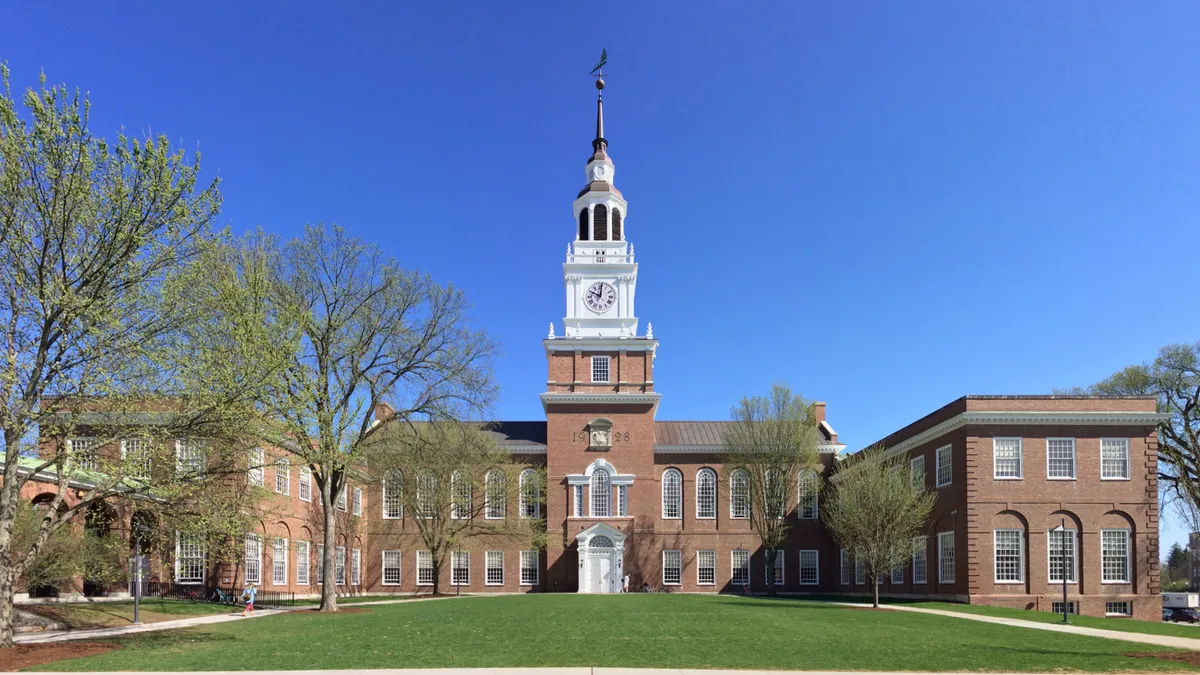Every aspect of colleges' budgets are suffering from the economic fallout of the coronavirus, and athletics departments are no exception. Their bottom lines are likely to be further stressed by a decreased payout from the NCAA. And observers fear far greater financial pressures on college sports should the pandemic extend into the fall.
Top NCAA leaders last week approved a $375 million cut to this year's funding for Division I member leagues, which are composed of the most expansive athletics programs in the country.
D I conferences will receive a total $225 million, much less than the nearly $600 million the NCAA initially planned to distribute. This reduction is a result of the coronavirus forcing the NCAA to cancel the lucrative D I men's basketball championship, from which it derives almost all of its revenue.
Division II conferences are expected to receive a little less than $14 million in NCAA revenue, a $30 million dip from last year. Division III will get about $10.7 million, a $22 million decrease. Overall, each division will likely lose about 70% of its estimated annual revenue, according to the NCAA.
How deeply the virus will affect the budgets of major athletics programs remains unclear for now, as the conferences will largely determine how much of the NCAA money goes to each institution within their purview.
Bob Bowlsby, commissioner of D I's Big 12 Conference, told reporters in a conference call last week the league initially anticipated receiving $24 million from the NCAA. Now it expects to get about $10 million. All told, the league will lose about $15 million to $18 million in revenue due to the coronavirus, Bowlsby said.
The Big 12 is part of the Power Five conferences, which are among the richest and most influential in Division I. Because of their wealth, the Power Five will likely not be as financially strained as their less-affluent counterparts, said Josephine Potuto, a law professor at the University of Nebraska-Lincoln and a former member of the NCAA's D I infractions committee. One Big 12 member, the University of Texas at Austin, took in the most athletics revenue of any NCAA school in the 2017-18 academic year, according to an analysis of institutions' financial statements by USA Today.
Bowlsby said the conference could draw on reserve funds to help mitigate the financial hit.
Less wealthy conferences weren't left completely without help, though.
The NCAA calculates the distribution to its member conferences through a complex set of formulas that divide the money into nine funds. In what was likely an attempt to protect some of the less-wealthy conferences, Potuto said, the NCAA decided to preserve the full funding, $53.6 million, in one of the pools that is divided equally among D I leagues.
The NCAA's funding formulas favor colleges with major athletics programs that generate money from the March Madness basketball championship, Potuto said. For instance, the largest of the other eight funds, which this year was supposed to be $167.6 million, is passed to conferences based on their performance in March Madness over a rolling six-season period.
The NCAA's top governing body, the Board of Governors, approved tapping into a $50 million reserve, and it expects to reap $270 million from an event cancellation insurance policy that it will use to pay off a line of credit it opened to cover the rest of this year's distribution.
"It's always been a juggling act," Potuto said of the NCAA distributions. "But that's probably going to get harder."
Most money colleges receive from the NCAA is passed to them through conferences. Institutions have wide latitude for how they use it to fund their athletics departments, including to help field teams whose activities generate little or no revenue.
Further exacerbating athletic departments' budget woes is the NCAA's decision to give student-athletes who play spring sports in D I programs an extra season of eligibility, as theirs was cut short by the health crisis.
"It's always been a juggling act. But that's probably going to get harder."

Josephine Potuto
Law professor, University of Nebraska-Lincoln
Colleges can also have more athletes on scholarships next spring than they usually are able, though they don't have to offer students who return for the extra season the same award amount as they did in 2019-20. However, not all leagues are honoring the offer.
Having additional athletes on the roster will impact budgets even more than funding cuts, predicted Walter Harrison, president emeritus of the University of Hartford and past chair of the NCAA's Executive Committee, the former iteration of the Board of Governors.
Well-resourced colleges that want their athletics programs to be competitive will likely field larger teams, which could spur other colleges to follow suit.
However, Harrison said, "you've got to pay for them somehow."
Eyes on the fall
Whether colleges and the leagues have the resources to weather further disruptions to the athletics calendar is unclear, particularly if the virus would curtail the revenue-rich fall football season. The White House extended social distancing measures through the end of April, but some experts believe they will be needed again around September.
The Power Five conferences can absorb a financial hit for now, but halting football would wipe out significant revenue for institutions, such as from home football games and merchandising, Potuto said.
About 53% of some 100 athletics directors in the D I Football Bowl Subdivision (FBS) surveyed recently believe the coronavirus will lead to decreased interest in attending games live.
Donors, taking into account the economic uncertainty, may be disinclined to give if a season is canceled, she said.
Colleges may be looking at small cuts to their sports budgets right now, such as limiting teams' travel, Potuto said. Should the football season be canceled, they may consider eliminating teams or reducing the number of athletes on their roster.
A majority of the FBS athletics directors (86%) believe their universities will need to make sacrifices in sports budgets because of the virus. Bowlsby acknowledged this grim prospect on last week's call: "Anything that I say regarding finances has to make the assumption we're going to be back to playing football in the fall."
"If that doesn't happen," he continued, "the underpinning of what we know as normal goes away and we'll have major changes to make."















